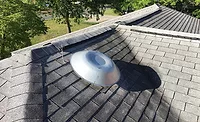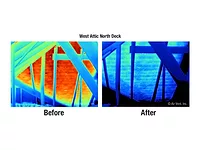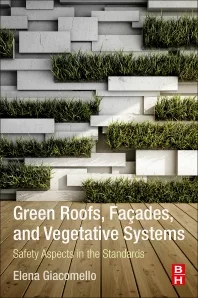What About Roofs in the South?
There’s no denying that cold temperatures, snowfall and eventual ice dams are more frequent, harsh and obvious in northern climates. But that does not remove the need for balanced attic ventilation – and attic insulation – during the winter in Texas, Georgia, Florida or any “southern” climate. So the next time a homeowner dismisses the contractor’s recommendation to improve the airflow inside the attic for year-round benefits, remind them that Mother Nature isn’t picky about the zip code of a house it visits or the month on the calendar.
“I live in the South, too. And although we obviously don’t get the same amount of snow and ice as the North, we do get an occasional heavy snow and a few ice storms,” said Jake Jacobson, vice president of SF5 Construction in Little Elm, Texas.
“I have seen ice on the north side of the roof in early fall. Not only is this adequate time for a potential leak to occur, but when the ice melts rapidly, the falling icicles create a dangerous situation,” Jacobson tells homeowners. “It only takes one storm to create an ice dam that could cause a leak.”
Then there’s the matter of dealing with the water vapor that the occupants of a house generate and where that water vapor goes in the winter.
On average, a family of four generates two to four gallons of water vapor each day just by living inside the house (Moisture Control in Buildings, Heinz R. Trechsel). One study measured up to six gallons! (Cooperative Extension Service of Clemson University, Linda L. Redmann).
If that warm water vapor (which is naturally drawn to the colder attic air during the cooler months of the year up north and down south) condenses on colder surfaces inside the attic, it can drip onto the insulation, potentially reducing the insulation’s R-Value.
“To help fight condensation from forming on the attic side of the roof’s deck (the iced tea effect), it’s important to ventilate the attic in the winter,” says Dean Estoll, project manager at Mike Huddleston Roofing Systems in Mansfield, Texas. “That condensation could lead to a variety of issues including mold and deterioration of the rafters or roof deck.”
If nothing else, remind homeowners that it’s already necessary to properly balance the attic ventilation system to help fight heat buildup. By default, the balanced system will now also fight potential winter-time problems.
“Here in the South, most homeowners know it’s important to ventilate their attic for heat purposes, but it’s also important to ventilate for moisture as well, and that’s primarily a winter-time issue,” says Nathan Speers, sales manager at Atlanta Reroof Specialists in Roswell, Ga. “By properly ventilating your attic in the summer, Mr. Homeowner, we can keep it cooler to fight heat buildup and also fight the moisture in the winter.”
Jacobson emphasized that geography shouldn’t trump common sense when it comes to roof systems.
“It doesn’t matter if you have a house in northern Quebec or southern Texas, proper attic ventilation is proper attic ventilation,” he said.
Looking for a reprint of this article?
From high-res PDFs to custom plaques, order your copy today!







